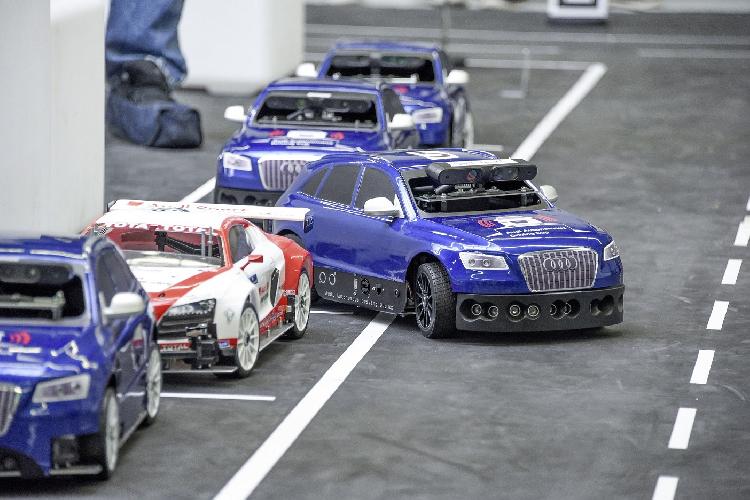
Audi Autonomous Driving Cup 2016: piloted driving on a 1:8 scale
On a quest to create the piloted model car: The Audi Autonomous Driving Cup will be held for the second time from March 22 to 24, 2016. Eight university teams will take part in the competition at the Audi museum mobile in Ingolstadt. The miniature-format, automated-drive Audi Q5 models will face a challenging circuit, with prize money of EUR 10,000 awaiting the winners.
Eight university teams have qualified for the competition and demonstrated huge enthusiasm in developing special algorithms to prepare their model cars for the final. Taking basic software supplied by Audi as the starting point, they have created their own software architecture to process the sensor data, interpret situations correctly and control the car accordingly. The aim is that the electric-drive model car should negotiate the circuit automatically as fast as possible, with a minimum of faults. The design of the circuit echoes the real-life conditions encountered on the road. The cars will have to avoid obstructions automatically, approach junctions with crossing traffic safely while observing the road signs, and follow other vehicles at a safe distance in flowing traffic. The challenges also include performing a left turn across oncoming traffic, precision parking maneuvers and an emergency brake application when obstructions suddenly appear.
The students will be building on the findings and functions of the previous year’s competition. The complexity of the challenge will therefore rise year by year. Points are deducted for accidents, lost time and imprecise execution. The compulsory part is followed by a freestyle element: For the final day of the competition, the teams can present an additional task for their model auto. This free choice of demonstration is above all about creativity. A presentation of the development philosophy also contributes to the final score. The team with the most points will receive EUR 10,000, the second-placed team EUR 5,000 and the third-placed EUR 1,000.
Audi presented each of the university teams, comprising a maximum of five students, with the basic software and two identical model cars on October 6, 2015. The plastic body of the blue Audi Q5 conceals a huge amount of technology. “Our engineers at Audi likewise use the ADTF development environment. That means the students work on optimizing their model cars in the same way we do on real cars,” explained competition committee member Dr.-Ing. Lars Mesow. “Thanks to the competition circuit’s challenging design, we expect the drives around it to yield conclusions that we can also transfer to software control algorithms in real-life driving situations.”
The main sensor used for the high-tech model cars is a color camera with range imaging. As on a real automobile, it detects the road surface, traffic signs, obstructions and other road users in front of the model car. It is complemented by ten ultrasound sensors: five at the front, three at the rear and one on each side. Their detection range of between two centimeters (0.8 in) and four meters (13.1 ft) makes it possible to identify the surroundings precisely even when traveling at speed. An acceleration sensor registers changes of direction by the model car and, like all other systems, sends this information in real time to the central on-board computer with high-speed quad-core processor. This setup mirrors the future electronics architecture of Audi. A central driver assistance controller unit (zFAS) in it evaluates sensor data, computes a model of the driving environment and supplies the information to all assistance systems.
Eight teams from the following universities have qualified for the final of the second Audi Autonomous Driving Cup:
- Albert Ludwigs University of Freiburg
- FZI Research Center for Information Technology, Karlsruhe
- Friedrich Alexander University of Erlangen-Nuremberg /
Nuremberg Institute of Technology - Leipzig University of Applied Sciences
- Ingolstadt University of Applied Sciences
- Technical University of Munich
- University of Bremen
- University of Würzburg
The participants are mostly masters students of Information Technology and Mathematics.
As well as the prize money, the Audi Autonomous Driving Cup offers interesting prospects for all participants: The competition also gives the students an opportunity to establish initial contact with Audi as a potential employer. The Company offers students internships, graduate thesis openings and attractive access schemes for graduates. Audi is cooperating with over 30 partner universities worldwide and promoting highly qualified young talent: 140 doctoral candidates are currently pursuing their doctorates in research projects funded by Audi.
The Audi Electronic Venture GmbH (AEV), a fully owned Audi subsidiary, is organizing the Audi Autonomous Driving Cup for the second time and supporting the participants in the run-up to the competition. All over the world the Audi subsidiary identifies innovative technologies, participates in start-ups and cooperates with companies from other industries. It acts as an innovation driver and think tank for new functions and software in the field of electronics development.



























